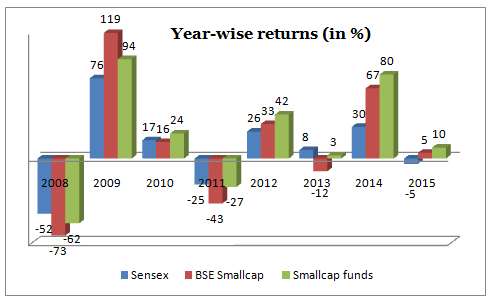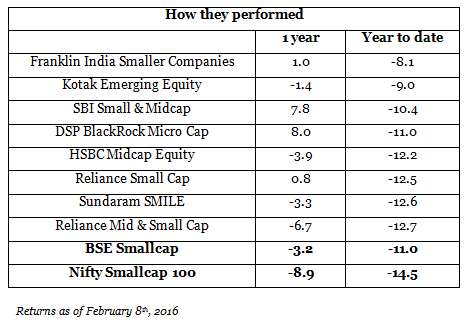Those who gleefully watched as returns in their mid-cap and small-cap funds ticked higher last year would be doing the opposite now. In the space of a few weeks, the double-digit returns several small-cap funds posted, even as the large-cap Nifty 100 index fell, have vanished.
This yo-yoing in returns, however, is the hallmark of small-cap funds. And if you are an investor in these funds, you must be able to take sudden losses in stride just as much as you exult in the gains.
The year for small-caps
Mid-cap and small-cap stocks took centre stage in the bull market that began in August 2013. These stocks had not participated as much as large-cap stocks in the rallies that took place after the 2008 crash. In 2013, at the time the Sensex broke through its 2008 peak of 21,206, the BSE Smallcap index was a good 56 per cent below its own 2008 peak.
In 2015, large-cap stocks began to fall, especially from August as signs of slowing global growth became clear. Mid-cap and small-cap stocks, though, clung resolutely to their gains. The Sensex lost 5.1 per cent for 2015, but the BSE Smallcap Index gained 5.5 per cent. In the entire bull run between August 2013 to March 2015, the Sensex gained 63.3 per cent, the larger BSE 100 gained 71 per cent, while the BSE Smallcap Index rocketed 119 per cent.
The valuation gap that the broad-market index, Nifty 500, had over the Nifty 50 was widening, indicating that smaller stocks were valued higher than large-caps. An additional factor buoying smaller stocks was that the correction started by foreign investors pulling out, and these investors had higher holdings in large-cap stocks.

Typically, in a strong bull market, mid-cap and small-cap stocks outstrip the blue-chips. In a correcting market, they fall much more as investors flock to stable companies and their risk appetite shrinks. The table alongside shows this pattern in returns for the Sensex and the BSE Smallcap Index in the market ups and downs since 2008. All this goes to show that the mid-cap and small-cap space was ripe for some correction. The simmering global trouble that came to a boil in January proved the trigger for this correction. In the year to date, the BSE Smallcap Index is down 11 per cent.
Category performance
Small-cap funds (13 in total) in the one-year period have returned 0.14 per cent. The BSE Smallcap Index suffered a 3.2 per cent loss. But given that the correction was recent, the year-to-date average category decline of 10.6 per cent gives a better idea of the fall. The BSE Smallcap Index dropped 11 per cent while the Nifty Smallcap 100 shed 14.5 per cent.
Here, we have taken funds with an average small-cap exposure over the past year of above 30 per cent as being a small-cap reliant fund, or those whose mandate specifically includes investing in small-cap stocks. Small-cap stocks are those with a market capitalisation of less than Rs. 2,500 crore, and mid-cap stocks are those whose market-cap ranges from Rs. 2,500 crore to Rs. 15,000 crore. Most small-cap funds have a good mix of mid-cap stocks.
In small-cap (and even mid-cap funds), portfolio emphasis is on stock selection, their return ratios, cash flows, leadership position, business prospects and valuations more than sector allocations. There is plenty to choose from too – several funds define their starting point as stocks whose market-cap is beyond the 100th stock.
Take for instance SBI Small and Mid-cap, whose year to date returns is just about better than the category average and its benchmark – BSE Smallcap Index. In its portfolio, stocks like TV Today, Manpasand Beverages, Gabriel India, and Radico Khaitan all of which are rooted in the consumer theme, held steady. But the same consumer stocks such as Indian Terrain, Relaxo Footwear, and D-Link declined by over 20 per cent.
Fund portfolios are very different and the way they react to falls or rises is thus divergent. Portfolio overlap between funds is much lower than in large-cap funds where the universe is smaller.
Who weathered it better

Let’s look at the funds that were worse off, first. Last year’s darlings, DSP BR Microcap and Reliance Smallcap, fared badly, down 11 and 12.5 per cent in the year to date against the BSE Smallcap’s 11 per cent decline. DSPBR Microcap saw its top holding of KPR Mills drop 16 per cent in the year to date. Eveready Industries, another top holding, dropped 25 per cent. The fund’s one-year return, though, at 8 per cent still holds well above the category average.
For Reliance Smallcap, its top five stocks – Intellect Design Arena, Navin Flourine International, Vindhya Telelinks, Kalpataru Power Transmission, and Arvind – dropped between 14 and 30 per cent in the year so far. Even in the one-year period, the fund just scraped past the category average with a return of 0.77 per cent.
Sundaram SMILE’s top stock Strides Shasun fell 21 per cent in the year to date; sharp declines were seen also in NRB Bearings, Gateway Distriparks, Navin Flourine, and TD Power Systems. The steep declines in these put paid to stocks that held up, such as Ashoka Buildcon, V-Guard Systems, and Karur Vysya Bank. The fund is worse than its category and the benchmark BSE Smallcap index in the one-year and year-to-date periods.
HSBC Midcap, another underperformer, erred on its timing as it lifted its small-cap allocation well above 30 per cent from September last year onwards, when it had been less than 20 per cent for much of the prior two years.
HDFC Small & Midcap Fund similarly raised small-cap exposure steadily over 2015 to 26 per cent of the portfolio, but still kept its returns above the average. The fund was also helped by its large-cap exposure in stocks such as Bajaj Finance.
Franklin India Smaller Companies (part of FundsIndia’s Select Funds list) contained declines better in the year to date and is also a category outperformer over the past year. What helped was its slight exposure to blue-chip stalwarts such as HDFC Bank and Yes Bank, holding more mid-caps than small-caps, and tending towards market leaders or niche companies such as eClerx Services, FAG Bearings, and Gulf Oil Lubricants, that therefore did not fall very sharply.
What should you do?
If you already hold small-cap funds, sit tight. Booking losses at this point will not be prudent, especially for those who got in last year. Small-cap funds require a time horizon of five years at least. Correction may well continue to make valuations more realistic and if the market sentiment sours further.
For those whose small-cap and mid-cap allocation in their portfolio is excessive, stop further investments in these funds, or invest more in large-cap funds to bring in a balance. If you want to enter the small-cap space now because the falls seem a good starting point, look for funds with low volatility or those that contain declines well.
Always judge fund performance relative to its benchmark and its category. An absolute fall of 8 per cent in a fund may not look so bad when you compare it with a 14 per cent drop in the small-cap index. The mark of a good fund is how well it contains a fall. The less the decline in returns, the more will be the gains once the sentiment turns and small-caps soar again.
FundsIndia’s Research team has, to the best of its ability, taken into account various factors – both quantitative measures and qualitative assessments, in an unbiased manner, while choosing the fund(s) mentioned above. However, they carry unknown risks and uncertainties linked to broad markets, as well as analysts’ expectations about future events. They should not, therefore, be the sole basis of investment decisions. To know how to read our weekly fund reviews, please click here.








How is Birla MNC Fund’s performance. Why was it not included in your select funds list ?
Hi Rajiv,
Birla MNC has been a steady outperformer from around 2010. Because of the move to quality, MNC stocks came to the fore. Most of them are cash rich and have stricter governance standards. We had covered the category last year – https://blog.fundsindia.com/blog/mutual-funds/fundsindia-reviews-mnc-funds/7409. We don’t include MNC funds in our regular analyses as they are theme-specific and not a regular diversified fund. Such funds are recommended only on a case to case basis.
Thanks,
Bhavana
How is Birla MNC Fund’s performance. Why was it not included in your select funds list ?
Hi Rajiv,
Birla MNC has been a steady outperformer from around 2010. Because of the move to quality, MNC stocks came to the fore. Most of them are cash rich and have stricter governance standards. We had covered the category last year – https://blog.fundsindia.com/blog/mutual-funds/fundsindia-reviews-mnc-funds/7409. We don’t include MNC funds in our regular analyses as they are theme-specific and not a regular diversified fund. Such funds are recommended only on a case to case basis.
Thanks,
Bhavana
How is Birla MNC fund performance.
I significantly enjoy your posts. Thanks
What type of debt funds should one invest in.
Is debt funds only for emergency purpose or if I want fund that are liquid and perform better than PO or FD which can be best
Do I do lumpsum or SIP in here as well.
what about AXIS liquid plan or escorts fund house
Hi Rajni,
Debt funds are used for both emergency purposes and for asset allocation in long-term portfolios. For your emergency corpus, ultrashort or liquid funds can be used. These two categories can be used to temporarily park any excess sums that you may have, until you decide what you want to do with it. Debt funds usually deliver returns higher than fixed deposits and are more tax efficient for long-term holding. Longer term debt or income funds can be used as part of your long-term portfolio, along with equity funds. It will bring in diversification in your portfolio and contain falls during bearish markets. To this end, investing through SIP will be the best bet. Do read these two posts for a more thorough understanding:
https://blog.fundsindia.com/blog/mutual-funds/income-funds-score-over-fixed-deposits/1324
https://blog.fundsindia.com/blog/mutual-funds/substitute-your-rd-with-sips-in-income-funds/3239
Thanks,
Bhavana
I significantly enjoy your posts. Thanks
What type of debt funds should one invest in.
Is debt funds only for emergency purpose or if I want fund that are liquid and perform better than PO or FD which can be best
Do I do lumpsum or SIP in here as well.
what about AXIS liquid plan or escorts fund house
Hi Rajni,
Debt funds are used for both emergency purposes and for asset allocation in long-term portfolios. For your emergency corpus, ultrashort or liquid funds can be used. These two categories can be used to temporarily park any excess sums that you may have, until you decide what you want to do with it. Debt funds usually deliver returns higher than fixed deposits and are more tax efficient for long-term holding. Longer term debt or income funds can be used as part of your long-term portfolio, along with equity funds. It will bring in diversification in your portfolio and contain falls during bearish markets. To this end, investing through SIP will be the best bet. Do read these two posts for a more thorough understanding:
https://blog.fundsindia.com/blog/mutual-funds/income-funds-score-over-fixed-deposits/1324
https://blog.fundsindia.com/blog/mutual-funds/substitute-your-rd-with-sips-in-income-funds/3239
Thanks,
Bhavana
Thanks Bhavana
Is this link for select fund list updated
http://www.fundsindia.com/select-funds
Hi Rajni,
Yes, the Select Funds page is updated every day to reflect the returns.
Thanks
So I can choose any fund you mentioned in Debt Long Term and start SIP for a period of 3-5 years. I just want to use this tool to generate better returns than PPF and FDS
is 5 year period a good outlook
Hi Rajni,
5 years is fine for a debt fund. For fund-specific queries, please log into your FundsIndia account and talk to our advisors. This blog is meant to be a general discussion forum only.
Thanks,
Bhavana
Thanks Bhavana
Is this link for select fund list updated
http://www.fundsindia.com/select-funds
Hi Rajni,
Yes, the Select Funds page is updated every day to reflect the returns.
Thanks
So I can choose any fund you mentioned in Debt Long Term and start SIP for a period of 3-5 years. I just want to use this tool to generate better returns than PPF and FDS
is 5 year period a good outlook
Hi Rajni,
5 years is fine for a debt fund. For fund-specific queries, please log into your FundsIndia account and talk to our advisors. This blog is meant to be a general discussion forum only.
Thanks,
Bhavana
How is Birla MNC fund performance.
How is Birla MNC fund performance.
How is Birla MNC fund performance.
How is Birla MNC fund performance.
How is Birla MNC fund performance.